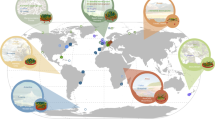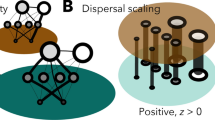Summary
Populations are regulated intrinsically (self-regulated) when the animals lower their rate of increase behaviorally or physiologically as a reaction to rising density. They are regulated extrinsically if the equilibrium is a mechanical consequence of interaction between the population and the organisms providing its food. We suggest that, at least for mammalian herbivores, self-regulation is unlikely to evolve unless the population's intrinsic rate of increase exceeds about 0.45 on a yearly basis. That value corresponds to a body weight of about 30 kg, the intrinsic rate being related inversely to body weight by r m=1.5 W-0.36 with W in kg.
The two dynamic strategies, self-regulation and extrinsic regulation, should enforce a bimodality of the frequency distribution of observed intrinsic rates of increase. This in turn might be reflected in a bimodality of body sizes, the smaller herbivores constituting the lower mode generally showing intrinsic regulation and the larger herbivores of the upper mode generally being regulated by extrinsic mechanisms. There is some empirical support for these predictions but it is by no means clearcut.
Mechanisms of self-regulation can evolve either by individual or group selection. Individual selection may act in two ways. By inhibiting their neighbours with some form of interference, individuals may increase their relative fitness without increasing their reproductive rate. Alternatively, individual selection may raise the absolute fitness of individuals and thereby raise the populations's intrinsic rate of increase. The population is destabilized if that process continues beyond a certain threshold and the population is then at significant risk of extinction at the troughs of the consequent oscillations. Selection between such populations will favour those carrying the beginnings of a self-regulating mechanism, and with that mechanism strengthened and fixed by continuing group selection, individual selection is again freed of the dynamic restraints on raising further the intrinsic rate of increase.
Similar content being viewed by others
References
Anderson RM, May RM (1980) Infectious diseases and population cycles of forest insects. Science 210:658–661
Andrewartha HG, Birch LC (1954) The distribution and abundance of animals. University of Chicago Press, Chicago
Armitage KB (1975) Social behavior and population dynamics of marmots. Oikos 26:341–354
Banfield AWF (1974) The mammals of Canada. Toronto University Press, Toronto
Bayliss P (1980) Kangaroos, plants and weather in the semiarid. MSc Thesis University of Sydney
Bonner JT (1965) Size and cycle: an essay on the structure of biology. Princeton University Press, Princeton
Bourliere F (1975) Mammals, small and large: the ecological implications of size. In: Golley FB, Petrusewicz K, Ryszkowski L (eds). Small mammals: their productivity and population dynamics. International Biological Programme 5, Cambridge University Press, Cambridge, pp 1–8
Bujalska G (1973) The role of spacing behaviour among females in the regulation of reproduction in the bank vole. J Reprod Fertil Suppl 19:465–475
Burton M (1976) Guide to the mammals of Britain and Europe. Elsevier Publishing projects SA, lausanne
Caughley G (1967) Parameters for seasonally breeding populations. Ecology 48:834–839
Caughley G (1970) Eruption of ungulate populations with emphasis on Himalayan thar in New Zealand. Ecology 51:53–72
Caughley G (1976a) Wildlife management and the dynamics of ungulate populations. In: Coaker TH (ed) Applied Biology Vol I. Academic Press London, pp 183–246
Caughley G (1976b) Plant-herbivore systems. In: May RM (ed) Theoretical ecology: principles and applications. WB Saunders, Philadelphia, pp 94–113
Caughley G (1977) Analysis of vertebrate populations. John Wiley and Sons, Chichester
Caughley G (1979) What is this thing called carrying capacity? In: Boyce MS, Hayden-Wing LD (eds) North American elk: ecology, behavior and management. The University of Wyoming, Laramie, pp 2–8
Caughley G (In press) Dynamics of large mammals and their relevance to culling. In: Owen-Smith N (ed) Proc symposium on management of large mammals in African conservation areas. Pretoria 1982
Chitty D (1960) Population processes in the vole and their relevance to general theory. Can J Zool 38:99–113
Chitty D (1967) The natural selection of self-regulatory behaviour in animal populations. Proc Ecol Soc Aust 2:51–78
Christian JJ (1971) Population density and reproductive efficiency. Biol Reprod 4:248–294
Christian JJ (1978) Neurobehavioral-endocrine regulation of small mammal populations. In: Snyder DP (ed) Populations of Small Mammals under Natural Conditions. Pymatuning Lab Ecol Spec Publ No 5
Damuth J (1981) Population density and body size in mammals. Nature 290:699–700
Dawson TJ, Hulbert AJ (1979) Standard metabolism, body temperature, and surface areas of Australian marsupials. Amer J Physiol 218:1233–1238
Dorst J, Dandelot P (1970) A field guide to the larger mammals of Africa. Collins, London
Fenchel T (1974) Intrinsic rate of natural increase: the relationship with body size. Oecologia 14:317–326
Fowler CW, Bunderson WT, Ryel RJ, Steele BB (1980) Comparative population dynamics of large mammals: a search for management criteria. Report to Marine Mammal Commision NTIS No PB80-178627
Gaines MS, McClenaghan Jr LR (1980) Dispersal in small mammals. Ann Rev Ecol Syst 11:163–196
Gilpin ME (1972) Enriched prey-predator systems: theoretical stability. Science 177:902–904
Gilpin ME (1975) Group selection in predator-prey communities. Princeton University Press, Princeton
Hall-Martin A (1980) Elephant survivors. Oryx 15:355–362
Harper JL (1977) Population biology of plants. Academic Press New York
Harrison J (1966) An introduction to mammals of Singapore and Malaya. Malayan Nature Society, Singapore
Healey MC (1967) Aggression and self-regulation of population size in deermice. Ecology 48:377–392
Heron AC (1972) Population ecology of colonising species: the pelagic tunicate Thalia democratica. Oecologia (Berlin) 10:269–312
Hickie PF (1936) Isle Royale moose studies. Proc North American Wildlife Conf 1:396–398
Holling CS (1965) The functional response of predators to prey density and its role in mimicry and population regulation. Mem Ent Soc Canda 45:3–60
Keith LB, Windberg LA (1978) A demographic analysis of the snowshoe hare cycle. Wildl Monogr No 58:1–70
King HD (1939) Life processes in grey Norway rats during fourteen years in captivity. Amer Anat Mem No 17:1–72
Kingdon J (1971–1982) East African mammals An atlas of evolution in Africa Vols I–IIID. Academic Press, London
Kleiber M (1961) The fire of life: an introduction to animal energetics. Wiley and Sons, New York
Klein DR (1968) The introduction, increase, and crash of reindeer on St Matthew Island. J Wildl Manage 32:350–367
Krebs CJ (1964) The lemming cycle at Baker Lake, Northwest Territories during 1959–1962. Arctic Inst N Amer Tech paper No 15:1–104
Krebs CJ (1971) Genetic and behavioral studies on fluctuating vole populations. In: Boer PJ den, Gradwell GR (eds) Proc Advanced Study Institute on dynamics of numbers in populations. Oosterbeek 1970, pp 243–256
Krebs CJ (1978) A review of the Chitty Hypothesis of population regulation. Can J Zool 56:2463–2480
Krebs CJ (1979) Dispersal, specing behaviour, and genetics in relation to population fluctuations in the vole Microtus townsendii. Fortschr Zool 25(2/3):61–77
Krebs CJ, Gaines MS, Keller BL, Myers JH, Tamarin RH (1973) Population cycles in small rodents. Science 179:35–41
Lack D (1954) The natural regulation of animal numbers. Oxford University Press London
Laws RM, Parker ISC, Johnstone RCB (1975) Elephants and their habitas: the ecology of elephants in North Bunyoro, Uganda. Clarendon Press Oxford
Leader-Williams N (1978) The history of the introduced reindeer of South Georgia. Deer 4:256–261
Lekagul B, McNeely J (1977) Mammals of Thailand. Kurusapha Ladprao Press Bangkok
Leslie PH (1945) On the use of matrices in certain population mathematics. Biometrika 33:183–212
Leslie PH, Venables UM, Venables LSV (1952) The fertility and population structure of the brown rat (Rattus norvegicus) in corn-ricks and some other habitats. Proc Zool Soc Lond 122:187–238
Lidicker WZ Jr (1975) The role of dispersal in the demography of small mammals. In: Golley FB, Petrusewicz K, Ryszkowski L (eds) Small mammals: their productivity and population dynamics. Interntional Biological Programme 5, Cambridge University Press Cambridge, pp 103–128
Lindstedt SL, Calder III WA (1981) Body size, physiological time, and longevity of homeothermic animals. Quart Rev Biol 56:1–16
Madison DM (1980) Space use and social structure in meadow voles, Microtus pennsylvanicus. Behav Ecol Sociobiol 7:65–71
Martin PS (1966) Africa and Pleistocene overkill. Nature 212:339–342
May RM (1974) Biological populations with non-overlapping generations: stable points, stable cycles, and chaos. Science 186:645–647
May RM (1975) Stability and complexity in model ecosystems. Princeton University Press Princeton, Second Edition
May RM (1976) Models for two interacting populations. In: May RM (ed) Theoretical ecology: principles and applications. WB Saunders, Philadelphia pp 49–70
May RM (1977) Thresholds and breakpoints in ecosystems with a multiplicity of stable states. Nature 269:471–477
Mech LD (1966) The wolves of Isle Royale. Fauna of the National Parks of the United States Fauna Series 7:1–201
Mech LD (1970) The wolf. Am Mus Nat Hist Press New York
Medway Lord (1969) The wild mammals of Malaya and offshore islands including Singapore. Oxford University Press, London
McCullough DR (1979) The George Reserve deer herd. The University of Michigan Press, Ann Arbor
McCullough DR (1982) Population growth rate of the George Reserve deer herd. J Wildl Manage 46:1079–1083
Milne AA (1928) The house at Pooh Corner. Chaucer Press Bungay
Nicholson AJ (1933) The balance of animal populations. J Anim Ecol 2:132–178
Noy-Meir I (1975) Stability of grazing systems: an application of predator-prey graphs. J Ecol 63:459–481
Noy-Meir I (1978) Stability in simple grazing systems: effect of explicit functions. J Theoret Biol 71:347–380
Oliff WD (1953) The mortality, fecundity and intrinsic rate of natural increase of the multimammate mouse, Rattus (Mastomys) natalensis (Smith) in the laboratory. J Anim Ecol 22:217–226
O'Roke EC, Hammerstrom Jr FN (1948) Productivity and yield of the George Reserve deer herd. J Wildl Manage 12:78–86
Owen-Smith N (1977) On territoriality in ungulates and an evolutionary model. Q Rev Biol 52:1–38
Peek JM (1980) Natural regulation of ungulates (what consititutes a real wilderness?). Wildl Soc Bull 8:217–227
Peterson RO, Stephens PW (1980) Ecological studies of wolves on Isle Royale. Annual Report 1979–1980, p 19
Romesburg HC (1981) Wildlife Science: gaining reliable knowledge. J Wildl Manage 45:293–313
Rosenzweig ML, MacArthur RH (1963) Graphical representation and stability conditions of prey-predator interactions. Amer Nat 97:209–223
Rothstein SI (1979) Gene frequencies and selection for inhibitory traits, with special emphasis on the adaptiveness of territoriality. Amer Nat 113:317–331
Sinclair ARE (1977) The African buffalo. A study of resource limitation of populations. University of Chicago Press Chicago
Smith FE (1954) Quantitative aspects of population growth. In: Boell EJ (ed) Dynamics of growth processes. Princeton University Press Princeton, pp 277–294
Southern HN (ed) (1964) The handbook of British mammals. Blackwell Scientific Publications Oxford
Tamarin RH (1980) Dispersal and population regulation in rodents. In: Cohen MN, Malpass RS, Klein HG (eds) Biosocial mechanisms of population regulation. Yale University Press New Haven, pp 117–133
Tanner JT (1975) The stability and intrinsic growth rates of prey and predator populations. Ecology 56:855–867
Terman CR (1980) Behavior and regulation of growth in laboratory populations of prairie deermice. In: Cohen MN, Malpass RS, Klein HG (eds) Biosocial mechanisms of population regulation. Yale University Press, New Haven, pp 23–36
Van den Brink FH (1967) A field guide to the mammals of Britain and Europe. Collins, London
Western D (1979) Size, life history and ecology in mammals. Afr J Ecol 17:185–204
Wyne-Edwards VC (1962) Animal dispersion in relation to social behaviour. Oliver and Boyd, Edinburgh
Author information
Authors and Affiliations
Rights and permissions
About this article
Cite this article
Caughley, G., Krebs, C.J. Are big mammals simply little mammals writ large?. Oecologia 59, 7–17 (1983). https://doi.org/10.1007/BF00388066
Received:
Published:
Issue Date:
DOI: https://doi.org/10.1007/BF00388066




